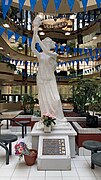1989 Tiananmen Square protests and massacre
Initial protests:
15 April – 4 June 1989
(1 month, 2 weeks and 6 days)
Massacre:
3–4 June 1989
(1 day); 35 years ago
Tiananmen Square 39°54′12″N 116°23′30″E / 39.90333°N 116.39167°E
- Death of Hu Yaobang
- Economic reform
- Inflation
- Political corruption
- Nepotism (especially regarding the children of Zhao Ziyang and Deng Xiaoping)
- Third wave of democracy
End of corruption within the Chinese Communist Party, as well as democratic reforms, freedom of the press, freedom of speech, freedom of association, social equality, democratic input on economic reforms
- Heavy casualties in urban clashes between rioters and soldiers in Beijing, especially at Muxidi
- Protest leaders and pro-democracy activists later exiled or imprisoned
- Rioters charged with violent crimes executed in the following months
- Zhao Ziyang purged from General Secretary and Politburo
- Jiang Zemin, previously Party Secretary of Shanghai, promoted to General Secretary and paramount leader by Deng Xiaoping
- Imposition of Western economic sanctions and arms embargoes on China
- Initiation of Operation Yellowbird
See Death toll
The protests were precipitated by the death of pro-reform Chinese Communist Party (CCP) general secretary Hu Yaobang in April 1989 amid the backdrop of rapid economic development and social change in post-Mao China, reflecting anxieties among the people and political elite about the country's future. The reforms of the 1980s had led to a nascent market economy that benefited some people but seriously disadvantaged others, and the one-party political system also faced a challenge to its legitimacy. Common grievances at the time included inflation, corruption, limited preparedness of graduates for the new economy,[5] and restrictions on political participation. Although they were highly disorganized and their goals varied, the students called for things like rollback of the removal of "iron rice bowl" jobs, greater accountability, constitutional due process, democracy, freedom of the press, and freedom of speech.[6][7] Workers' protests were generally focused on inflation and the erosion of welfare.[8] These groups united around anti-corruption demands, adjusting economic policies, and protecting social security.[8] At the height of the protests, about one million people assembled in the square.[9]
As the protests developed, the authorities responded with both conciliatory and hardline tactics, exposing deep divisions within the party leadership.[10] By May, a student-led hunger strike galvanized support around the country for the demonstrators, and the protests spread to some 400 cities.[11] In response, the State Council declared martial law on May 20[11] and on June 2, the CCP's Politburo Standing Committee made the decision to use military force to clear the square, leading to clashes between the military and demonstrators.[12][13][14] Estimates of the death toll vary from several hundred to several thousand, with thousands more wounded. The vast majority of those killed were civilians, though a small number of soldiers were also killed.[15][16][17][18][19][20]
The event had both short and long term consequences. Western countries imposed arms embargoes on China,[21] and various Western media outlets labeled the crackdown a "massacre".[22][23] In the aftermath of the protests, the Chinese government suppressed other protests around China, carried out mass arrests of protesters[24] which catalyzed Operation Yellowbird, strictly controlled coverage of the events in the domestic and foreign affiliated press, and demoted or purged officials it deemed sympathetic to the protests. The government also invested heavily into creating more effective police riot control units. More broadly, the suppression ended the political reforms begun in 1986 and halted the policies of liberalization of the 1980s, which were only partly resumed after Deng Xiaoping's Southern Tour in 1992.[25][26][27] Considered a watershed event, reaction to the protests set limits on political expression in China that have lasted up to the present day.[28] The events remain one of the most sensitive and most widely censored topics in China.[29][30]
1989 Tiananmen Square protests and massacre
June Fourth Incident
Liù-Sì Shìjiàn
Liù-Sì Shìjiàn
ㄌㄧㄡˋ ㄙˋ ㄕˋ ㄐㄧㄢˋ
Liu4-Szu4 Shih4-chien4
Liòu-Sìh Shìh-jiàn
Lyòu-Sz̀ Shr̀jyàn
Loh-sy Zy-ji
Lùhk-sei Sih gihn
Luk4sei3 si6 gin6
La̍k-sù Sū-kiaⁿ
1989年春夏之交的政治风波
1989年春夏之交的政治風波
Political turmoil between the Spring and Summer of 1989
1989-nián chūn xià zhījiāo de zhèngzhì fēngbō
1989-nián chūn xià zhījiāo de zhèngzhì fēngbō
1989-nien2 chʻun1 hsia4 chih1-chiao1 te0 cheng4-chih4 feng1-po1
1989-ni tshen-ghô tsy-jiau di tsen-tsy fhon-bo
1989-nìhn cheūnhaah jígáau dī jingchìh fūngbō
1989-nin4 ceon1ci4 fung1bo1
1989-nî chhun-hē chi-kau tī chèng-tī hong-pho
八九民运
八九民運
Eighty-Nine Democracy Movement
Bā-Jiǔ Mínyùn
Bā-Jiǔ Mínyùn
ㄅㄚ ㄐㄧㄡˇ ㄇㄧㄣˊ ㄩㄣˋ
Pa1-Chiu3 Min2-yün4
Ba-Jiǒu Mín-yùn
Bā-Jyǒu Mínyùn
poh-cieu Min-yiuin
baatgáu màhnwahn
baat3 gau2 man4 wan6
pat-káu bîn-ūn





